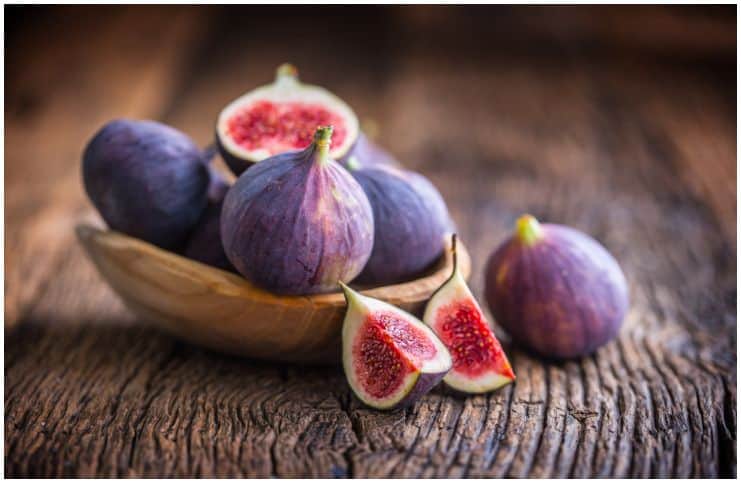Figs (Anjeer) – Side Effects, Nutrition Facts, Uses, Health Benefits:
For centuries figs (also known as anjeer) have been used to treat disorders like hemorrhoids and diabetes, along with respiratory, liver, and urinary diseases.
Many of their active compounds show great potential in the fight against these and other infections. When dried, the fruits have the highest concentration of antioxidant polyphenols of all of the dried fruits.
The common fig tree (scientific name Ficus carica, from the Moraceae family) is native to southwest Asia and the eastern Mediterranean and is one of the first plants that were cultivated by humans.
It grows wild in sunny and dry areas, with deep and fresh soil, but also in rocky areas, from sea level to 1,700 meters.
Remnants of figs have been found in excavations of sites traced to at least 5,000 B.C.
These fruits played an important part in the diet of both the ancient Romans and Greeks. Plato wrote that Greek athletes at Olympia were fed with these fruits in order to improve their overall performance and strength.
In Rome, this tree was considered an emblem of the future prosperity of the race.
Nutrition Facts
It contains diverse phytochemicals, including polyphenols such as gallic acid, chlorogenic acid, syringic acid, vitamins – A, B1, B2, B3, B6, C, E, K, minerals – calcium, iron, magnesium, phosphorus, sodium, zinc and potassium.
Uses and Health Benefits
Anti-inflammatory Activity
Due to high levels of another flavonoid, called luteolin, the fruits have very specific anti-inflammatory actions in the body. Luteolin is considered by some to be a super nutrient as it helps reduce inflammation and promotes nerve and muscle function.
Luteolin is a natural anti-oxidant with not as much pro-oxidant potential as the most studied flavonoid quercetin but seemingly with a better safety profile. In addition, observations propose that luteolin could be an anticancer agent for different types of cancer. Further, recent epidemiological studies have accredited a cancer prevention property to luteolin. (1)
During Pregnancy
They are very high in iron, a mineral that represents an important part of hemoglobin, the compound in the blood that carries oxygen throughout the body. Iron also carries oxygen in muscles, helping them function properly.
Additionally, it helps increase your resistance to disease and stress. Hence, it is important to consume more iron while you are pregnant to ensure that you and your baby are getting enough oxygen and to avoid symptoms of weakness, tiredness, irritability, and depression.
Digestion and Weight Loss
These fruits are high in both insoluble and soluble fiber. Soluble fiber helps to slow down your digestion. This helps you feel full longer and is one reason why dietary fiber also may help with weight control.
In addition, it’s good for soothing irritable bowel syndrome (IBS). Insoluble fiber supplies the bulk needed to help cleanse the large intestine and eliminate waste easily, reducing constipation incidences.
Thus, naturally high in dietary fiber, anjeer can be a useful food to include in the diet for those watching their weight.
These amazing fruits also contain prebiotics, the fuel for good bacteria, which helps build a healthy microbiome, our defense system against toxins we encounter from poor quality tap water, the environment, and common yeast and viruses or other types of fungi.
Lower Blood Pressure
They are a good source of potassium. A diet that includes natural sources of potassium is essential in controlling blood pressure because potassium lessens the effects of sodium. In our body, potassium is mainly found inside the cells.
Potassium plays an important role throughout the body and is involved in the same functions as sodium, but with a complementary role and the balance between the two elements is crucial.
The best sources of potassium are fresh foods with limited processing because processing can impact the potassium balance. On the other hand, raw foods are naturally low in sodium and processed foods are our main dietary source of sodium.
Macular Degeneration
Another great health benefit of figs is that they help fight macular degeneration. Macular degeneration is a medical condition that may result in blurred or no vision in the center of the visual field.
It most frequently occurs in people over the age of 50, and in the U. S. is the most common cause of vision loss in this age group. Eating figs regularly has been proven to be a good way to slow or stop the onset of macular degeneration.
Healthy Skin
Eating figs can contribute to healthy skin. It has an anti-inflammatory effect and can be applied to the skin in lotions and scrubs to reduce inflammation and redness of the skin.
A 2014 study, which was aimed to investigate the effects of a cream containing Ficus carica fruit extract on various skin parameters, concluded that a stable topical cream containing F. carica fruit extract has an effect on trans-epidermal loss, skin melanin, hydration values, and sebum content. (2)
Type 2 Diabetes Mellitus Prevention
Some evidence also suggests that the leaves of Ficus carica could help regulate the symptoms of diabetes.
A 2003 study concluded that fig extract can help treat diabetes by normalizing blood fatty acid and vitamin E levels. (3) Another study in 1998 showed that supplementation with Ficus carica reduced postprandial glycemia. (4)
Side Effects of Figs (Anjeer)
Overeating may cause diarrhea or loose stools. Overconsumption of figs can also be heavy on the stomach.


